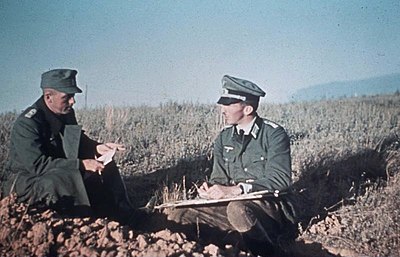Feldgrau 🎨 RGB Color Code: #4D5D53
The hexadecimal RGB code of Feldgrau color is #4D5D53. This code is composed of a hexadecimal 4D red (77/256), a 5D green (93/256) and a 53 blue component (83/256). The decimal RGB color code is rgb(77,93,83). Closest WebSafe color: Dim gray (#666666)
GSearch on Google
RGB
HSV
CMYK
Quick use
Click and Copy the codes below for quick use.
Shades & Tints
Complementary Color
Feldgrau on Wikipedia

Feldgrau (English: field-grey) is a grayish green color. It was the official basic color of military uniforms of the German armed forces from the early
traditional Imperial and Reichswehr uniform color of grey-green "field gray" (feldgrau) wool, but incorporated four front patch pockets with scalloped flaps and
(2020-08-04). "5.SS-Panzer-Division "Wiking" (History, Battles, Org, Service)". Feldgrau. Retrieved 2022-11-12. Lepre, George (1997). Himmler's Bosnian Division:
first recorded use of morning blue as a color name in English is unknown. Feldgrau (field grey) was the color of the field uniform of the German Army from
Rodeike 1995, pp. 167–176. "German phonetic alphabet of World War II." feldgrau.com. Retrieved: 2 January 2010. Ebert, Kaiser & Peters 1992, p. 137. Nowarra
Überzug faded into a tan shade. In October 1916 the colour was changed to feldgrau (field grey), although by that date, the plain metal Stahlhelm was standard
Retrieved 2021-07-20. "Imperial Austrian-Hungarian Danube Flotilla". Feldgrau. 2020-08-04. Retrieved 2021-07-20. "A-H Danube Flotilla". www.gwpda.org
It is more commonly called olive green or olive drab. Khaki University Feldgrau Maerz and Paul A Dictionary of Color New York:1930 McGraw-Hill Page 197;
Retrieved 23 December 2012. "Bordfliegergruppe 196". Feldgrau. 4 August 2020. "Trägergruppe 186". Feldgrau. 4 August 2020. "Seefliegerverbände 1939-45". www

Use the palette to pick a color or the sliders to set the RGB, HSV, CMYK components. Search for a color by its name in the list containing more than 2000 names.
There are many ways to mix/generate a color. Computer screens display the required color mixing tiny red, green and blue lights (RGB). Turning off all three components results in a black pixel, while if all components are lit up on full brightness that results a white light.
In print we use cyan, yellow, magenta and black (CMYK) inks because usually we print on a white paper. In this case the lack of the ink will result white paper, and we get a dark shade if more colors are mixed together. We can also define a color by hue, saturation and value (HSV).





